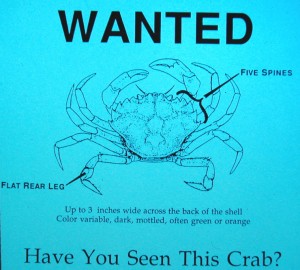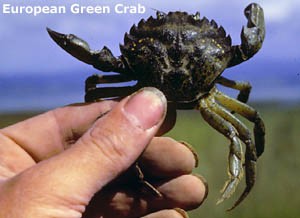Next time you visit a low tide at the beach, and you see lots of crabs scuttling about, I want you to think about an invader in their midst. One of the top 100 worst invasive alien species, according to the Global Invasive Species Database.
Who is it?
The European Green Crab – Carcinus maenas (Linneaus, 1758)

Poster used to help communities identify the invasive green crab from native ones. Courtesy of www.exoticsguide.org.
Identifying the European green crab (1, 13)
- 5 spines along the outside of the carapace from eyes towards legs
- 3 bumps between the eyes
- Fan shaped carapace
- Flat rear leg
- Found in variety of colours
- < 10cm in carapace width
The invasion
The European green crab has invaded areas including parts of the east coast of Canada and the US, as well as the west coast (3, 10, 13). Its native range includes Europe and parts of northern Africa (13). On the west coast it is thought introduction was via San Francisco in 1989 (6, 10). The crab larvae were carried north, reaching the west coast of Vancouver Island during the 1997/1998 El Nino event (10, 13, 15). The crab population is now expanding (5, 15) as expected with the introduction (6).
There is a predator among us
These critters have an aggressive nature, eating a wide range of species causing competition with native species (1, 3, 10, 11, 13). These green crabs cause ecological damage due to predation, exploiting the lack of predator response to the crab (1, 2, 3, 7, 9). Bivalve aquaculture has suffered economic loss due to predation (8, 13). These crabs are fast and aggressive feeders, able to out compete native predatory crabs (1, 7, 11, 13, 14). The farther the species spreads, the more predatory control is placed on populations and community structures.
Are we fighting back?
There have been minimal activities to control the crab on the west coast, while many ideas have been discussed on the east coast. Some include fencing, trapping, poisoning and commercial fisheries (4, 8). I believe that there needs to be more discussion in BC to gain action before this invasive species expands further. I believe that a recreational fishery on Vancouver Island could help solve this growing problem, with the help of proper legislation and public education. However, there are two sides to having a fishery:
Pros
- Provides control on the species, preventing probable expansion (5)
- More political talk about problems from the species
- Is a delicacy in parts of Europe (8)
- Commercial fisheries exist in France, Portugal and Spain (8)
- Great nutritional benefits (12)
- Similar to Dungeness Crab
- High in n-3 fatty acids
- Location of crabs known due to monitoring (5)
Cons
- Introducing the taste to palate
- Possible loss of image as an invader
- Public education about the fishery and regulations
- Potential further introduction by uneducated fishers
Introducing a recreational fishery would bring about more discussion and action towards controlling this invasive crab. Maybe we will soon be eating green crab meat for a healthier coastal ecology!
This recent Nature Now podcast (10) covers more information about the impact of the European green crab on the west coast, helping gain much needed public awareness on this species. Take a listen!
References
- Aliens among us. c2011. Green Crab: Carcinus maenas. Royal BC Museum; [accessed 2015 Oct 5]. http://alienspecies.royalbcmuseum.bc.ca/eng/species/green-crab.
- Antos, C., Berg, M., Fahmy, S. 2014. The effect of chemical effluent: experimental evidence for poor predatory recognition by Nucella ostrina in the presence of Carcinus maenas. Report submitted for Directed Studies at the Bamfield Marine Sciences Centre.
- Department of Fisheries and Aquaculture. 2015. The Invasion… European Green Crab; [accessed 2015 Oct 12]. http://www.fishaq.gov.nl.ca/education/The%20Invasion…European%20Green%20Crab.pdf.
- Fulton, B.A and Fairchild, E.A. 2013. Nutritional analysis of whole green crab, Carcinus maenas, for application as a forage fish replacement in agrifeeds. Sustainable Agriculture Research. [accessed 2015 Oct 13]; 2(3): 126-135. http://www.ccsenet.org/journal/index.php/sar/article/view/27903/16842.
- Gillespie, G.E., Phillips, A.C., Paltzat, D.L., Therriault., T.W. 2007. Status of the European green crab, Carcinus maenas, in British Columbia – 2006. Fisheries and Oceans Canada. Canadian Technical Report of Fisheries and Aquatic Sciences 2700. [accessed 2015 Oct 5].
- Jamieson, G.S., Grosholz, E.D., Armstrong, D.A., Elner, R.W. 1998. Potential ecological implications from the introduction of the European green crab, Carcinus maenas (Linneaus), to British Columbia, Canada, and Washington, USA. Journal of Natural History. [accessed 2015 Sept 29]; 32(10-11): 1587-1598. DOI: 10.1080/00222939800771121.
- Kamprath, A. 2013. We’re gonna need a bigger crab trap: The effects of an invasive predator on the hiding behaviour of a native shore crab. Report submitted for Marine Behavioural Ecology at the Bamfield Marine Sciences Centre.
- Klassen, G., Locke, A. 2007. A biological synopsis of the European green crab, Carcinus maenas. Fisheries and Oceans Canada. Canadian Manuscript Report of Fisheries and Aquatic Sciences 2818. [accessed 2015 Oct 5].
- Kratchmer, S. 2009. Green means go, red means stop: Anti-predator behaviour of the marine gastropod Chlorostoma funebralis to chemical cues from the invasive European green crab, Carcinus maenas. Report submitted for Marine Behavioural Ecology at the Bamfield Marine Sciences Centre.
- Nature Now: #226 Invasive European Green Crabs. 2015. KPTZ 91.9fm; [accessed 2015 Oct 8]. https://kptz.org/226-invasive-european-green-crabs/
- Pocock, K. 2014. Competitice interactions between invasive European green crabs Carcinus maenas and native Dungeness crabs Metacarcinus magister. Report submitted for Directed Studies at the Bamfield Marine Sciences Centre.
- Skonberg, D.I. and Perkins, B.L. 2002. Nutrient composition of green crab (Carcinus maenas) leg meat and claw meat. Food Chemistry. [accessed 2015 Sept 29]; 77: 401-404. http://www.sciencedirect.com.ezproxy.library.ubc.ca/science/article/pii/S0308814601003648.
- Washington Department of Fish and Wildlife. 2015. Aquatic Invasive Species: Carcinus maenas (European Green Crab); [accessed 2015 Oct 8]. http://wdfw.wa.gov/ais/carcinus_maenas/#observations
- Wongk, D., Sidley, R., Waters, N. 2014. Metacarcinus gracilis walk sideways because they have nothing to look forward to: A comparison of feeding rates between native Metacarcinus gracilis and Carcinus maenas under different flow regimes. Report submitted for Directed Studies at the Bamfield Marine Sciences Centre.
- Yamada, S.B. and Gillespie, G.E. 2008. Will the European green crab (Carcinus maenas) persist in the Pacific Northwest? ICES Journal of Marine Science. [accessed 2015 Oct 7]; 65(5): 725-729. http://icesjms.oxfordjournals.org/content/65/5/725.full.

Recent Comments